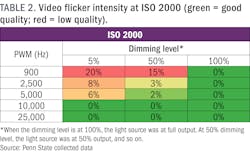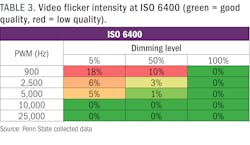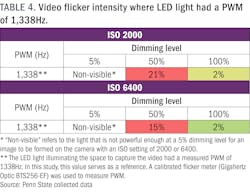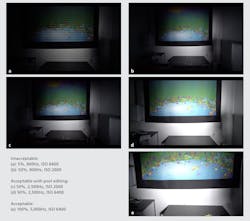VIDEO LIGHTING | ISO settings and LED dimming impact video quality
Architectural lighting design and video production share many similarities in their approach to creating impactful visual experiences. Both disciplines involve the careful consideration of factors such as color, light intensity, distribution, and overall atmosphere to enhance viewers’ or users’ engagement with the space or content.1,2 Whether designing a lighting scheme for a building or producing a video that evokes specific emotions, the ultimate goal is to captivate and engage the audience.
In video production, in-house LED lighting systems that adversely affect the quality of the recorded footage are not uncommon. Figure 1 illustrates an example of the visual discrepancies that can arise between the camera and the LEDs as dark lines. These issues can significantly decrease the overall video image quality and hinder the creative vision of the production.
To address these challenges, this article aims to explore the effect of pulse-width modulation (PWM) and dimming on the visual quality of video production. By investigating the impact of PWM dimming techniques on different lighting parameters and their compatibility with cameras, we can learn how to achieve optimal lighting conditions and overcome the limitations imposed by certain LED systems. Ultimately, this knowledge may help video producers and lighting designers enhance the visual quality of their work and ensure a seamless integration of lighting and camera technologies.
Methods
To address the occurrence of dark lines in recorded footage, the research team conducted an experiment to examine the relationship between camera settings, PWM of the LEDs, and relative light levels. The experiment was conducted at the Pennsylvania State University Lighting Lab, where we focused on illuminating a painting on a wall using an LED light source. A Sony A7Sii camera with a 24–70mm Zeiss lens was mounted on a tripod positioned next to the LED, directed toward the painting.
First, we investigated the role of ISO settings on dark lines occurrence in videos. For indoor video recordings, ISO values between 600 and 6400 are commonly used, with higher ISO values used for lower lighting conditions. By varying the ISO settings, we analyzed their influence on the occurrence of dark lines in the video.
Next, we explored the impact of PWM on video image quality. PWM is a method of dimming LED lights by rapidly alternating between on and off states, creating the illusion of steady dimmed light3, as shown in Fig. 2. We focused on adjusting the frequency in hertz (Hz), which determines the duration of time the lights are on versus off. It is crucial to note that PWM dimming involves controlled “flickering” of the LED strip, resulting in varying light output and perceived brightness, despite appearing continuous to human vision. That is, the light source does not produce constant light output, even if it appears so to the observer. Figure 3 shows the banding observed in the recorded video at a 50% dimming level, 2000 ISO, and PWM of 900Hz. (PWM is measured in hertz while duty cycle is expressed as the percentage of time the lights are on versus off.)
The camera recorded at a rate of 24 frames per second (fps) for 10 to 15 seconds at a focal length of 35mm. The shutter speed was set to 1/125th second with an f4 aperture. The camera was positioned to capture video of still-life objects, including a painting and table, in the space used to highlight the difference in light.
First, we tested the light fixture at 100% output. The video showed no signs of dark lines because the luminaire’s duty cycle has no “off” state. When the lights were dimmed below 100%, the dark lines began to appear. At an output of 50%, we noted variations in the intensity of the dark lines. When PWM decreased, as indicated in Tables 1 and 2, the flicker intensity increased. This trend was consistent at different ISO values and at a 5% light output as well. The results of our experiment (Tables 1–4) summarize the impact of PWM, ISO, and dimming levels on the presence of dark lines in the recorded video.
We calculated the lightness difference between the darkest area of the banded lines with the brightest part of the non-banded area using the CIELAB L*ab lightness value in Adobe Photoshop; the CIELAB L*ab lightness value ranges between 0 and 100, with a higher value representing a brighter image4. The lightness difference between dark and bright bands was assessed using a color scale that indicates the degree of acceptable banding. Green represents an acceptable level, yellow indicates acceptability with post-production adjustments, while orange/red signifies an unacceptable level; a percentage exceeding 6% was considered unacceptable. Figure 4 demonstrates the quality of images with the different acceptability degrees.
The results indicate that both PWM and dimming level have a significant impact on the occurrence of dark bands. When the LEDs are set at full output, no banding is observed at the listed PWMs. However, when the dimming levels drop below 100% output, the likelihood of banding occurrence depends on the PWM of the lighting fixtures, the dimming level, and camera settings. Typically, higher-quality luminaires feature a faster PWM duty cycle, reducing the chances of banding. Low-quality equipment, on the other hand, tends to have slower PWM, leading to a higher risk of banding.
Ensuring high-quality footage is crucial in video production. Recorded footage with banding falling within the unacceptable range of flicker intensity does not yield useful results. Failure to address this issue ultimately leads to an unsatisfactory image quality, as shown in Fig. 4a and b.
Recommendations
Several steps can be taken to address banding issues in video recordings. First, when scouting for locations, users can identify areas with high light levels. For places with low light levels, adding new light sources to increase light levels can help avoid banding. Taking test photographs and observing the camera performance before the actual video shoot can also help detect potential issues, as can measuring light levels at prospective locations with a calibrated illuminance or luminance meter. Modern cameras allow real-time video feedback via an LCD display. Validate the image quality on spot with the camera and set lighting to 100% output (no dimming) to lower the chances of banding occurring. Attaching a portable light or providing off-camera lighting at a high output (90%–100%) can also help reduce banding.
Increasing the camera ISO settings can further alleviate banding, although higher settings may introduce digital noise. If the banding remains unacceptable, consider slight adjustments to the shutter speed and frame rate, keeping in mind that these will have an impact on captured movement and quality. A slower shutter speed and a higher frame rate will lessen the banding intensity.
Conclusions
Our experiment focused on the impact of ISO, PWM, and dimming level on video quality. When the LED luminaire had a PWM frequency of approximately 10,000Hz and was set at 100% output, banding issues were not encountered. In venues where light sources with such high PWM frequencies are not available, banding problems may arise as lights are dimmed below 100%.
To mitigate band intensity appearing in the footage, we raised the camera ISO when the video flicker intensity fell into the yellow/orange zones (Table 3). The footage became unacceptable when the PWM was 900 to 1,500Hz and the dimming level was 50% or lower.
The findings from this study provide quantitative evidence of the banding problem and help identify the conditions that negatively impact the video image quality. By systematically analyzing the camera settings, dimming levels, and pulse-width modulation of light sources, we aim to provide valuable insights into the effects of PWM on quality for video production. These findings should assist professionals in optimizing their camera settings and lighting setups to mitigate dark lines and achieve superior video quality. Our study utilized only one camera model; banding for other camera makes and models should be investigated in the future.
REFERENCES
1. C. Gloman and T. LeTourneau, Placing Shadows: Lighting Techniques for Video Production, Routledge (2012).
2. R.S. Berns, Billmeyer and Saltzman’s Principles of Color Technology, John Wiley & Sons (2019).
3. L. Svilainis, “LED brightness control for video display application,” Displays, 29(5), 506–511 (2008).
4. D. Durmus, “CIELAB color space boundaries under theoretical spectra and 99 test color samples,” Color Research & Application, 45(5), 796–802 (2020).
PHILIP DURE, J. MUNDINGER, and ALP DURMUS conduct architectural and lighting research at Penn State University in State College, Pa.
Follow our LinkedIn page for our latest news updates, contributed articles, and commentary, and our Facebook page for events announcements and more. You can also find us on the X platform.

Philip Dure
PHILIP DURE is a recent graduate of architectural engineering (AE) at the Pennsylvania State University. He completed his B.S. in spring 2023 and will be working full time with BR+A as an electrical design engineer. Throughout his years at Penn State, Dure served as the Mentoring Vice President of the Student Society of Architectural Engineers, program coordinator of the Multicultural Engineering Program, Senator of NSBE, and Vice President of Visionary Visual Arts. His interests include videography, art, and graphic design, which led him to start up his own production company, Dooray Productions LLC.

J. Mundinger
J. MUNDINGER, PhD, is a research technologist and practitioner instructor of lighting design with the Department of Architectural Engineering at the Pennsylvania State University. Mundinger uses his work in color science, lighting controls, and STEM pedagogy to inspire and empower the next generation of architectural lighting designers. His industry partners in Project CANDLE keep him firmly grounded to the needs of a changing lighting industry as he prepares his students to create a brighter future for all.

Alp Durmus
ALP DURMUS, PhD, is an assistant professor in the Department of Architectural Engineering at the Pennsylvania State University. He completed his PhD at the University of Sydney, Australia before moving to the U.S. to join Pacific Northwest National Laboratory (PNNL) as a postdoctoral researcher and later senior associate lighting research scientist. Durmus later joined Penn State's AE department as a professor in architectural lighting. His research and teaching interests are color science, lighting design, visual perception, adaptive lighting systems, energy efficiency, light pollution, circadian photobiology, and image quality assessment.


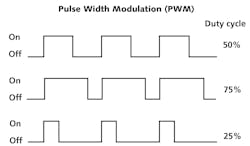
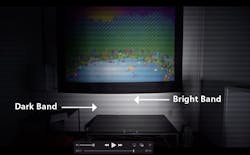
![TABLE 1. CIELAB lightness (L*ab) [4] in dark and bright bands of the images taken under different dimming levels and frequency. TABLE 1. CIELAB lightness (L*ab) [4] in dark and bright bands of the images taken under different dimming levels and frequency.](https://img.ledsmagazine.com/files/base/ebm/leds/image/2023/10/2310LED_dur_Table1.6531ab50404dd.png?auto=format,compress&fit=max&q=45&w=250&width=250)
